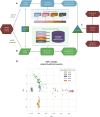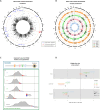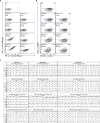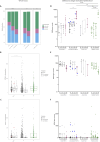Heterozygous BTNL8 variants in individuals with multisystem inflammatory syndrome in children (MIS-C)
- PMID: 39576310
- PMCID: PMC11586762
- DOI: 10.1084/jem.20240699
Heterozygous BTNL8 variants in individuals with multisystem inflammatory syndrome in children (MIS-C)
Abstract
Multisystem inflammatory syndrome in children (MIS-C) is a rare condition following SARS-CoV-2 infection associated with intestinal manifestations. Genetic predisposition, including inborn errors of the OAS-RNAseL pathway, has been reported. We sequenced 154 MIS-C patients and utilized a novel statistical framework of gene burden analysis, "burdenMC," which identified an enrichment for rare predicted-deleterious variants in BTNL8 (OR = 4.2, 95% CI: 3.5-5.3, P < 10-6). BTNL8 encodes an intestinal epithelial regulator of Vγ4+γδ T cells implicated in regulating gut homeostasis. Enrichment was exclusive to MIS-C, being absent in patients with COVID-19 or bacterial disease. Using an available functional test for BTNL8, rare variants from a larger cohort of MIS-C patients (n = 835) were tested which identified eight variants in 18 patients (2.2%) with impaired engagement of Vγ4+γδ T cells. Most of these variants were in the B30.2 domain of BTNL8 implicated in sensing epithelial cell status. These findings were associated with altered intestinal permeability, suggesting a possible link between disrupted gut homeostasis and MIS-C-associated enteropathy triggered by SARS-CoV-2.
© 2024 Bellos et al.
Conflict of interest statement
Disclosures: A.H. Tremoulet reported non-financial support from Janssen Pharmaceuticals outside the submitted work. C.-E. Luyt reported personal fees from Advanzpharma, grants from Merck, and non-financial support from Pfizer outside the submitted work. A.C. Hayday reported grants from Takeda Pharmaceuticals, and personal fees from ImmunoQure AG, Prokarium, and TransImmune AG outside the submitted work; in addition, A.C. Hayday had a patent to US20210246187A1 pending (Takeda). No other disclosures were reported.
Figures











References
-
- Abolhassani, H., Delavari S., Landegren N., Shokri S., Bastard P., Du L., Zuo F., Hajebi R., Abolnezhadian F., Iranparast S., et al. . 2022. Genetic and immunologic evaluation of children with inborn errors of immunity and severe or critical COVID-19. J. Allergy Clin. Immunol. 150:1059–1073. 10.1016/j.jaci.2022.09.005 - DOI - PMC - PubMed
-
- Assante, G., Tourna A., Carpani R., Ferrari F., Prati D., Peyvandi F., Blasi F., Bandera A., Le Guennec A., Chokshi S., et al. . 2022. Reduced circulating FABP2 in patients with moderate to severe COVID-19 may indicate enterocyte functional change rather than cell death. Sci. Rep. 12:18792. 10.1038/s41598-022-23282-x - DOI - PMC - PubMed
-
- Asuni, N., and Wilder S.. 2019. VariantKey: A reversible numerical representation of human genetic variants. bioRxiv. 10.1101/473744 (Preprint posted February 15, 2019). - DOI
MeSH terms
Substances
Supplementary concepts
Grants and funding
- MR/S032304/1/UK Research and Innovation
- Francis Crick Institute
- UL1 TR001866/TR/NCATS NIH HHS/United States
- 108439/Z/15/Z/WT_/Wellcome Trust/United Kingdom
- FC001003/CRUK_/Cancer Research UK/United Kingdom
- Imagine Institute
- R01 AI163029/AI/NIAID NIH HHS/United States
- JPB Foundation
- Fisher Center for Alzheimer's Research Foundation
- 202131-32-33/Fundació La Marató de TV3
- EC-GA no. 279185/European Union's Seventh Framework Programme
- R33HD105590/National Institute for Child Heath and Development
- EQU201903007798/French Foundation for Medical Research
- PA0873/NIHR Imperial Biomedical Research Centre
- Rockefeller University
- EQU202103012670/Fondation pour la recherche Medicale
- Imperial College London
- 58READIE/MRC_/Medical Research Council/United Kingdom
- Meyer Foundation
- ES/M001660/1/Economic and Social Research Council
- Generalitat de Catalunya
- Battersea & Bowery Advisory Group
- R01AI163029/NH/NIH HHS/United States
- Grandir - Fonds de solidarité pour l'enfance
- 848196/European Union's Horizon 2020 research and innovation
- 2021SGR00899/Agencia de Gestión de Ayudas Universitarias y de Investigación
- Institut National de la Santé et de la Recherche Médicale
- R33 HD105590/HD/NICHD NIH HHS/United States
- R21 AI160576/AI/NIAID NIH HHS/United States
- French Ministry of Higher Education, Research, and Innovation
- HHMI/Howard Hughes Medical Institute/United States
- Square Foundation
- Fondation du Souffle
- SCOR Corporate Foundation for Science
- St. Giles Foundation
- MR/N01104X/1 2018-2020/Economic and Social Research Council
- General Atlantic Foundation
- 101057100/H2020 UNDINE HORIZON-HLTH-2021-DISEASE-04
- FC001003/WT_/Wellcome Trust/United Kingdom
- ACCI20-759/CIBERER
- ANR-10-IAHU-01/French National Research Agency
LinkOut - more resources
Full Text Sources
Medical
Molecular Biology Databases
Miscellaneous

